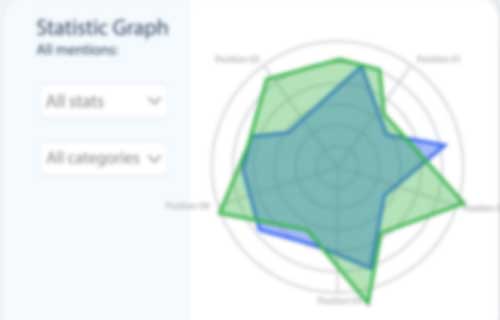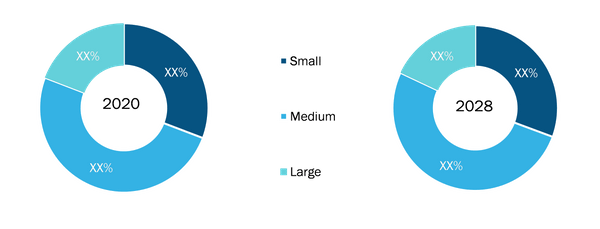The residential food processors market was valued at US$ 3,475.21 million in 2021 and is projected to reach US$ 5,553.20 million by 2028; it is expected to grow at a CAGR of 6.9% from 2021 to 2028.
In 2020, Asia Pacific dominated the global residential food processors market and is expected to retain its dominance during the forecast period. The increase in the working population across the region has led to increasing demand for convenient household and kitchen appliances. These factors are expected to propel the demand for residential food processors across the region. In addition, the change in consumers’ lifestyles has led to increased adoption of modernized household and kitchen appliances. The rising population in countries such as China and India has led to increased construction of residential houses and complexes having limited kitchen space. Thus, this lead to an increased demand for small kitchen appliances, such as mini food processors.
Customize Research To Suit Your Requirement
We can optimize and tailor the analysis and scope which is unmet through our standard offerings. This flexibility will help you gain the exact information needed for your business planning and decision making.
Residential Food Processors Market: Strategic Insights

Market Size Value in US$ 3,475.21 million in 2021 Market Size Value by US$ 5,553.20 million by 2028 Growth rate CAGR of 6.9% from 2021 to 2028. Forecast Period 2021- 2028 Base Year 2021

Shejal
Have a question?
Shejal will walk you through a 15-minute call to present the report’s content and answer all queries if you have any.
 Speak to Analyst
Speak to Analyst
Customize Research To Suit Your Requirement
We can optimize and tailor the analysis and scope which is unmet through our standard offerings. This flexibility will help you gain the exact information needed for your business planning and decision making.
Residential Food Processors Market: Strategic Insights

| Market Size Value in | US$ 3,475.21 million in 2021 |
| Market Size Value by | US$ 5,553.20 million by 2028 |
| Growth rate | CAGR of 6.9% from 2021 to 2028. |
| Forecast Period | 2021- 2028 |
| Base Year | 2021 |

Shejal
Have a question?
Shejal will walk you through a 15-minute call to present the report’s content and answer all queries if you have any.
 Speak to Analyst
Speak to Analyst
Residential Food Processors Market Forecast, by Region, 2021–2028
- Sample PDF showcases the content structure and the nature of the information with qualitative and quantitative analysis.
Market Insights
Increasing Demand for Convenient Products
Consumer lifestyle has become hectic in recent years due to increased work pressure, making them feel exhausted after their regular working hours. Working professionals increasingly prefer convenient, automated, and smart household and kitchen appliances that can save their time and effort. The residential food processors are multifunctional and fast. These food processors work effectively and significantly to ease the cooking process even if a user is cooking for a large number of people.
Size Insights
Based on the size, the residential food processors market is segmented into small, medium, and large. In 2020, the medium segment dominated the market. The increased constraint of kitchen size and space in developing countries is one of the factors driving the demand for medium-size residential food processors. The medium residential food processor includes a medium slicing disc, a shredding disc, and a stainless steel chopping blade for processing.
Residential Food Processors Market Share, by Size – 2020 and 2028


- Sample PDF showcases the content structure and the nature of the information with qualitative and quantitative analysis.
Koninklijke Philips N.V., Whirlpool Corporation, Breville Group Limited, De’Longhi Appliances S.r.l., Conair Corporation, Robert Bosch GmbH, MAGIMIX, SharkNinja Operating LLC, Groupe SEB, and Spectrum Brands Inc. are among the key players operating in the residential food processors market. The leading players adopt several strategies, such as mergers & acquisitions and product launches, to expand their geographic presence and consumer base.
Report Spotlights
- Progressive trends in the residential food processors industry to help players develop effective long-term strategies
- Business growth strategies adopted by companies to secure growth in developed and developing markets
- Quantitative analysis of the global residential food processors market from 2019 to 2028
- Estimation of the demand for residential food processors across various industries
- PEST analysis to illustrate the efficacy of buyers and suppliers operating in the industry to predict the market growth
- Recent developments to understand the competitive market scenario and the demand for the residential food processors
- Market trends and outlook coupled with factors driving and restraining the growth of the residential food processors market
- Understanding regarding the strategies that underpin commercial interest with regard to the global residential food processors market growth, aiding in the decision-making process
- Residential food processors market size at various nodes of market
- Detailed overview and segmentation of the global residential food processors market as well as its industry dynamics
- Residential food processors market size in various regions with promising growth opportunities
The "Global Residential Food Processors Market Analysis to 2028" is a specialized and in-depth study of the consumer goods industry with a special focus on the global residential food processors market trend analysis. The report aims to provide an overview of the market with detailed market segmentation. The residential food processors market is segmented on the basis of size, distribution channel, and geography. Based on the size, the market is segmented into small, medium, and large. Based on distribution channel, the residential food processors market is segmented into supermarkets and hypermarkets, specialty stores, online retail, and others. Based on geography, the market is segmented into five main regions—North America, Europe, Asia Pacific, the Middle East and Africa, and South and Central America.
Company Profiles
- Koninklijke Philips N.V.
- Whirlpool Corporation
- Breville Group Limited
- De’Longhi Appliances S.r.l.
- Conair Corporation
- Robert Bosch GmbH
- MAGIMIX
- SharkNinja Operating LLC
- Groupe SEB
- Spectrum Brands Inc.

Report Coverage
Revenue forecast, Company Analysis, Industry landscape, Growth factors, and Trends

Segment Covered
Size, Distribution Channel, and Geography

Regional Scope
North America, Europe, Asia Pacific, Middle East & Africa, South & Central America

Country Scope
Argentina, Australia, Brazil, Canada, China, Egypt, France, Germany, India, Italy, Japan, Mexico, Russian Federation, Saudi Arabia, South Africa, South Korea, United Arab Emirates, United Kingdom, United States
Frequently Asked Questions
The major players operating in the global residential food processors market are Koninklijke Philips N.V.; Whirlpool Corporation; Breville Group Limited; De’Longhi Appliances S.r.l.; Conair Corporation; Robert Bosch GmbH; MAGIMIX; SharkNinja Operating LLC; Groupe SEB; and Spectrum Brands Inc.
In 2020, Asia Pacific accounted for the largest share of the global residential food processors market. The countries in the region, such as China, India, and South Korea, are witnessing an upsurge in the middle-class population and growth in urbanization. The changing lifestyle of the consumers and increasing working population are propelling the adoption of modernized household and kitchen appliances.
In 2020, the medium-size segment accounted for the largest market share. Medium-size residential food processors have a capacity of 9 to 12 cups and are great for making four portions of food at a time. It is suitable for chopping, dicing, mincing, and slicing. It is used for shredding hard cheeses, carrots, sprouts, and potatoes and pureeing soups, sauces, desserts, and dips. These food processors are also available with the multi-purpose dough blade and reversible slicing or shredding disc for preparing a variety of shapes and sizes ideal for recipes.
On the basis of distribution channels, online retail is the fastest-growing segment. Ecommerce platforms offer many products of various categories to customers across the world. Consumers can buy any product online from their homes or offices. Online retail is the fastest-growing distribution channel for the residential food processors market owing to many factors, such as ease of accessibility, availability of a wide range of products, cashback, discount coupons, and attractive deals. Aided by the disruption of physical stores due to the Covid-19 pandemic and lockdowns, the market for the online retail segment is expected to grow rapidly in the next few years.
In 2020, specialty stores held the largest market share in the global residential food processors market. Specialty stores focus on the specific product category and have wide product varieties. The stores provide a personalized shopping experience and a positive retail environment to the customers. They offer value-added products to their customers and focus on customer satisfaction. Moreover, specialty stores usually have trained staff who can assist the customers in making the purchase decisions. For the residential food processors market, specialty stores are expected to maintain their market prominence amongst other distribution channels due to the availability of specific products under one roof, pleasant atmosphere of store, and the presence of skilled staff that can help the customer choose the right product.
Asia Pacific is expected to be the fastest growing region within the global residential food processors market. The rising population in countries such as China and India have led to an increase in the construction of residential houses and complexes having limited kitchen space. Thus, there is an increased demand for multifunctional and small kitchen appliances. Thus, mini residential food processor is preferred in such countries in terms of convenience because they are lightweight, multifunctional and require little space. Thus, the rapidly changing lifestyle of consumers, increasing awareness related to eco-friendly products, and the rising trend of automation in day-to-day activities to save time are providing lucrative opportunities for the residential food processors market in Asia-Pacific.
The List of Companies - Residential Food Processors Market
- Koninklijke Philips N.V.
- Whirlpool Corporation
- Breville Group Limited
- De’Longhi Appliances S.r.l.
- Conair Corporation
- Robert Bosch GmbH
- MAGIMIX
- SharkNinja Operating LLC
- Groupe SEB
- Spectrum Brands, Inc
The Insight Partners performs research in 4 major stages: Data Collection & Secondary Research, Primary Research, Data Analysis and Data Triangulation & Final Review.
- Data Collection and Secondary Research:
As a market research and consulting firm operating from a decade, we have published many reports and advised several clients across the globe. First step for any study will start with an assessment of currently available data and insights from existing reports. Further, historical and current market information is collected from Investor Presentations, Annual Reports, SEC Filings, etc., and other information related to company’s performance and market positioning are gathered from Paid Databases (Factiva, Hoovers, and Reuters) and various other publications available in public domain.
Several associations trade associates, technical forums, institutes, societies and organizations are accessed to gain technical as well as market related insights through their publications such as research papers, blogs and press releases related to the studies are referred to get cues about the market. Further, white papers, journals, magazines, and other news articles published in the last 3 years are scrutinized and analyzed to understand the current market trends.
- Primary Research:
The primarily interview analysis comprise of data obtained from industry participants interview and answers to survey questions gathered by in-house primary team.
For primary research, interviews are conducted with industry experts/CEOs/Marketing Managers/Sales Managers/VPs/Subject Matter Experts from both demand and supply side to get a 360-degree view of the market. The primary team conducts several interviews based on the complexity of the markets to understand the various market trends and dynamics which makes research more credible and precise.
A typical research interview fulfils the following functions:
- Provides first-hand information on the market size, market trends, growth trends, competitive landscape, and outlook
- Validates and strengthens in-house secondary research findings
- Develops the analysis team’s expertise and market understanding
Primary research involves email interactions and telephone interviews for each market, category, segment, and sub-segment across geographies. The participants who typically take part in such a process include, but are not limited to:
- Industry participants: VPs, business development managers, market intelligence managers and national sales managers
- Outside experts: Valuation experts, research analysts and key opinion leaders specializing in the electronics and semiconductor industry.
Below is the breakup of our primary respondents by company, designation, and region:

Once we receive the confirmation from primary research sources or primary respondents, we finalize the base year market estimation and forecast the data as per the macroeconomic and microeconomic factors assessed during data collection.
- Data Analysis:
Once data is validated through both secondary as well as primary respondents, we finalize the market estimations by hypothesis formulation and factor analysis at regional and country level.
- 3.1 Macro-Economic Factor Analysis:
We analyse macroeconomic indicators such the gross domestic product (GDP), increase in the demand for goods and services across industries, technological advancement, regional economic growth, governmental policies, the influence of COVID-19, PEST analysis, and other aspects. This analysis aids in setting benchmarks for various nations/regions and approximating market splits. Additionally, the general trend of the aforementioned components aid in determining the market's development possibilities.
- 3.2 Country Level Data:
Various factors that are especially aligned to the country are taken into account to determine the market size for a certain area and country, including the presence of vendors, such as headquarters and offices, the country's GDP, demand patterns, and industry growth. To comprehend the market dynamics for the nation, a number of growth variables, inhibitors, application areas, and current market trends are researched. The aforementioned elements aid in determining the country's overall market's growth potential.
- 3.3 Company Profile:
The “Table of Contents” is formulated by listing and analyzing more than 25 - 30 companies operating in the market ecosystem across geographies. However, we profile only 10 companies as a standard practice in our syndicate reports. These 10 companies comprise leading, emerging, and regional players. Nonetheless, our analysis is not restricted to the 10 listed companies, we also analyze other companies present in the market to develop a holistic view and understand the prevailing trends. The “Company Profiles” section in the report covers key facts, business description, products & services, financial information, SWOT analysis, and key developments. The financial information presented is extracted from the annual reports and official documents of the publicly listed companies. Upon collecting the information for the sections of respective companies, we verify them via various primary sources and then compile the data in respective company profiles. The company level information helps us in deriving the base number as well as in forecasting the market size.
- 3.4 Developing Base Number:
Aggregation of sales statistics (2020-2022) and macro-economic factor, and other secondary and primary research insights are utilized to arrive at base number and related market shares for 2022. The data gaps are identified in this step and relevant market data is analyzed, collected from paid primary interviews or databases. On finalizing the base year market size, forecasts are developed on the basis of macro-economic, industry and market growth factors and company level analysis.
- Data Triangulation and Final Review:
The market findings and base year market size calculations are validated from supply as well as demand side. Demand side validations are based on macro-economic factor analysis and benchmarks for respective regions and countries. In case of supply side validations, revenues of major companies are estimated (in case not available) based on industry benchmark, approximate number of employees, product portfolio, and primary interviews revenues are gathered. Further revenue from target product/service segment is assessed to avoid overshooting of market statistics. In case of heavy deviations between supply and demand side values, all thes steps are repeated to achieve synchronization.
We follow an iterative model, wherein we share our research findings with Subject Matter Experts (SME’s) and Key Opinion Leaders (KOLs) until consensus view of the market is not formulated – this model negates any drastic deviation in the opinions of experts. Only validated and universally acceptable research findings are quoted in our reports.
We have important check points that we use to validate our research findings – which we call – data triangulation, where we validate the information, we generate from secondary sources with primary interviews and then we re-validate with our internal data bases and Subject matter experts. This comprehensive model enables us to deliver high quality, reliable data in shortest possible time.
Trends and growth analysis reports related to Residential Food Processors Market

Feb 2022
Nicotine Pouches Market
Size and Forecasts (2020 - 2030), Global and Regional Share, Trend, and Growth Opportunity Analysis By Strength (Less than 6 mg/g, 6 mg/g to 12 mg/g, and More than 12 mg/g), Flavor [Original/Plain, and Flavored (Mint, Berry, Citrus, Fruity, Others)], Distribution Channel (Supermarkets and Hypermarkets, Convenience Stores, Online Retail, and Others)

Feb 2022
Housewares Market
Size and Forecasts (2020 - 2030), Global and Regional Share, Trends, and Growth Opportunity Analysis Report Coverage: By Product Type (Cookware and Bakeware, Tableware, Kitchen Appliances, Bathroom Essentials, and Others) and Distribution Channel (Supermarkets and Hypermarkets, Specialty Stores, Online Retail, and Others)

Feb 2022
False Hair Products Market
Size and Forecasts (2020 - 2030), Global and Regional Share, Trends, and Growth Opportunity Analysis Report Coverage: By Product Type (Hair Extension, Hair Wig, and Hair Pieces), Material (Human Hair and Synthetic Hair), End User (Men, Women, and Kids), and Distribution Channel (Supermarkets and Hypermarkets, Specialty Stores, Online Retail, and Others)

Feb 2022
Mosquito Traps Market
Forecast to 2030 - Global Analysis by Product Type (Electric Shock Mosquito Killer, Photocatalytic Mosquito Killer, and Sticky Trap Mosquito Killer), Category (Outdoor and Indoor), Distribution Channel [Direct Sales (Direct Offline Sales and Direct Online Sales) and Retail Sales (Supermarkets & Hypermarkets, Specialty Stores, Online Retail, and Others)]

Feb 2022
Wicket Mailer Envelopes and Bags Market
Forecast to 2028 - COVID-19 Impact and Global Analysis By Material Type {Plastic [Polyethylene (PE), Polypropylene (PP), Polyethylene Terephthalate (PET), and Others] and Paper}, Product Type (Poly Wicket Bags, Paper Wicket Bags, Poly Wicket Mailers, and Paper Wicket Mailers), and End Use (Banking & Financial Services, Courier & Logistics, Retail, and Others)